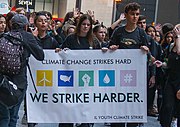BaCCC/Module 7/Lesson 3/Part 1
Contents
Module 7, Lesson 3: You Are a Climate Champion
Introduction
Lesson 3 culminates and confirms your journey as a climate champion. The focus of Lesson 3 will be on how you can live your ideals as a climate change influencer. It will provide you with further ideas to help you draw up an entire plan to put climate change advocacy into action.
Chin up, Champ! You are very close to being done!
Terminology
The following terms are important in understanding the science behind climate change. If you want to remember them, write their meanings in your learning journal as you encounter them in the course content.
- advocacy
- influencer
Ideas on how to be a climate champion
Throughout this course, you have been hearing, reading and thinking about the science of climate change and its impacts, as well as different strategies for mitigating and adapting to those impacts. You have learnt about green and blue jobs, read stories and case studies about other climate champions and been introduced to climate justice and intersectionality.
Now it is time to decide on a climate change communication project or climate change activity in relation to ACE that can be adapted to your own setting and sphere of influence. (This is not the same as the mitigation and adaptation strategies you chose for your own family or household in earlier modules.) What you are now encouraged to come up with is a public outreach project that entails climate change communication and/or climate action. The following story might give you some ideas.
Here is a way to come up with more possible ideas for your project.
Are you ready to choose a project to get to work on?
Keep yourself motivated in moving your project idea forward. Follow the links below for more inspiration.
1. Climate action (and communication) can be as simple as spreading the word, through any medium you choose.
- Join a global movement such as Count Us In, which aims to inspire 1 billion people to take practical steps and challenge their leaders to act more boldly on climate.
- Encourage your friends, family, neighbours, classmates, co-workers or whole community to reduce their carbon pollution. UNEP lists 16 ways they can do that:
16 Ways to Take Climate Action[3]
2. An important part of climate change communication is keeping up the pressure on politicians, governments and political groups.
Speak up. UNEP has suggestions for using your voice in
- political circles
- your work circle
- your personal life
- the economy
- your volunteer circles
You can learn more about the possibilities at:
Things You Can Do in a Climate Emergency[4]
Lobby local politicians and businesses to support efforts to cut emissions and reduce carbon pollution. Act Now Speak Up! UNEP (see link above) has sections on political pressure and corporate action.
Count Us In also has some suggestions for how to do this at:
| “ | Pick a climate change issue you care about, decide on a specific request for change and then try to arrange a meeting with your local representative. It might seem intimidating but your voice deserves to be heard. If humanity is to succeed in tackling the climate emergency, politicians must be part of the solution. It’s up to all of us to keep up with the pressure. | ” |
| —UNEP | ||
10 Ways You Can Help Fight the Climate Crisis[6]
Remember, your elected representatives are hearing all the time from professional lobbyists who are paid by fossil fuel corporations and other carbon-intensive industries to influence legislators and lawmakers. It is time for citizen voices to get louder than the lobbyists’ voices.
References
- ↑ UNDP. n.d. “We Can Move Forward:” How Papua New Guinean Youth Are Leading the Charge Against Climate Change
- ↑ Count Us In. n.d. Count Us In
- ↑ ENEP n.d. 16 Ways to Take Climate Action
- ↑ UNEP. n.d. Things You Can Do in a Climate Emergency
- ↑ Count Us In. n.d. Tell Your Politicians
- ↑ UNEP. n.d. 10 Ways You Can Help Fight the Climate Crisis
- ↑ UNDP. n.d. Looking For a Seat at the Table Next Generation PNG Leaders
